Wheat is one of the major food crop. Therefore, in order to get a high yield of wheat, it becomes necessary that we should know what are the diseases that occur in wheat crop, what are their symptoms and how they can be prevented. Most of the wheat diseases are caused by fungi, which sometimes cause excessive damage to the crop.
The major diseases of wheat and their management are as follows. Let us know in detail about the diseases of wheat.
Rusts of wheat
Wheat rust is caused by fungi. The symptoms of rust disease appear on wheat crop just like rusty iron. There are three types of rust that occur in wheat crops.
- Yellow rust or stripe rust
- Brown rust or leaf rust
- Black rust or stem rust
Yellow rust or stripe rust
This disease is caused by a fungus called Puccinia striiformis. The weather with low temperature and high humidity is favorable for yellow rust disease. Therefore, there is a possibility of occurring yellow rust disease in the months of January and February. The outbreak of this disease is more often seen in cold and high humidity areas.
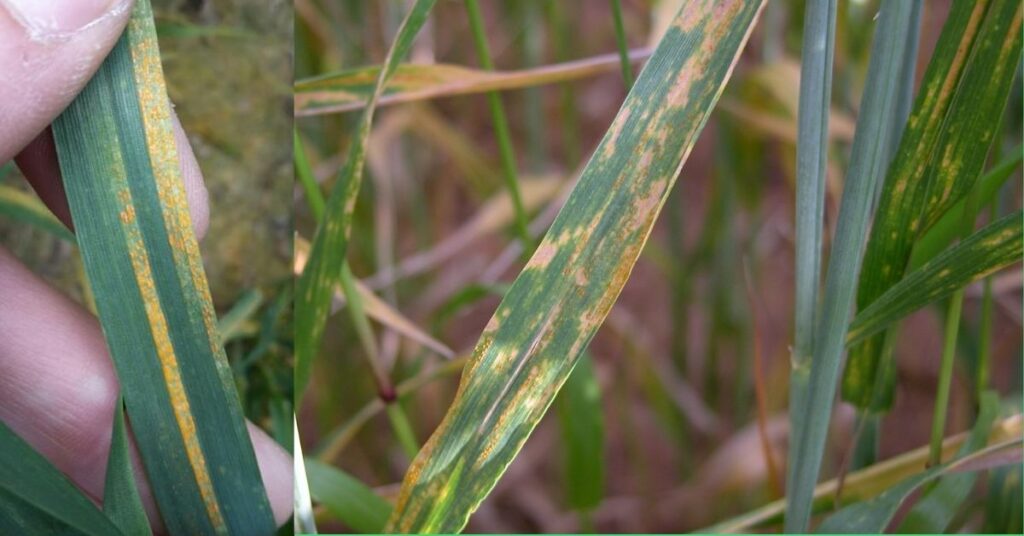
Symptoms
In this disease, yellow pustules (stripes) appear on the upper surface of the leaves. As the disease progresses, the entire leaves turn yellow. The yellow pustules (stripes) appearing on the leaves turn black as the temperature rises. The growth of the affected plants is stunted, especially when the disease occurs at or before the tillering stage of wheat.
Yellowing of the leaves of wheat can also be due to lack of essential plant nutrients or waterlogging, but due to yellow rust disease, yellow powder is also formed on the leaves of wheat, due to which the hand turns yellow when the leaves are touched.
Brown rust or leaf rust
Brown rust or leaf rust disease is caused by a fungus called Puccinia recondita. Symptoms of this disease appear when the crop is 5-6 weeks old. Brown rust or leaf rust appears in the last week of December. The temperature of 15-25 ℃ is favorable for this disease. This disease is found almost all over India wherever wheat is cultivated.
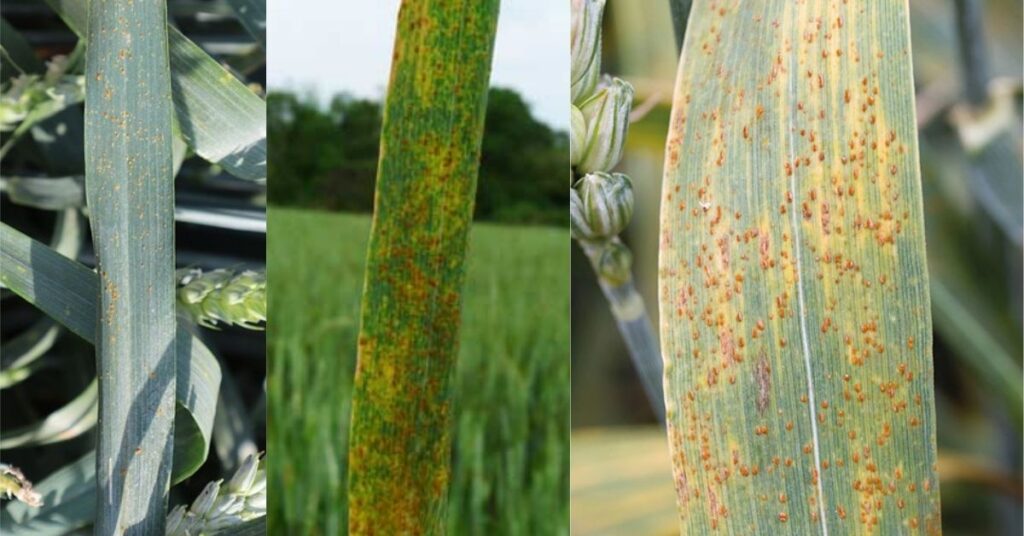
Symptoms
- At the beginning of disease, very small (like needle tip) scattered brown or orange pustules (spots) are formed on the upper surface of the leaves.
- As the adverse effect of the disease increases, these pustules (spots) become dense and spread as dark brown color all over the leaves.
- At the last stages of the disease, these pustules (spots) turn black in color and the disease stops spreading.
- The leaves of the plants affected by the disease dry up before the ripening of crop.
- In affected plants, the grains become shriveled and small.
Black rust or stem rust
- This disease is caused by a fungus called puccinia graminis tritici. The effect of this disease is more on late sown crops.
- This disease is more prevalent in hot and humid environments. The temperature of 20-30℃ is favorable for this disease.
- Symptoms of this disease are seen in South and Central India.
- Usually the symptoms of this disease are seen in the first week of March.
- Symptoms of this disease produce on the stem.
- In this disease, long reddish-brown raised pustules (spots) are formed on the stem of wheat, which can be seen in other parts of the plant as the disease progresses.

Wheat rust management/control
- For the prevention of all types of rust of wheat, rust resistant varieties should be sown.
- Only treated seeds should be sown, If farmers want to sow the seeds available with them, then sow the seeds after treatment.
- Sow the crop on time.
- Do not irrigate more than required and use only the proper amount of nitrogen.
- For control of yellow rust, spray Propiconazole 25 EC @200ml/Acre in 150-200 liters of water or spray with 0.1% solution of Tebuconazole 250 EC.
- Spray Zineb 75% WP (Dithane Z-78) for control of black and brown rust disease.
- For the control of Brown rust and black rust of wheat spray with Mencozeb 75% WP @400-500 gm/acre 150-200 litres of water.
Loose Smut of wheat
Loose smut of wheat is a seed borne fungus disease. It is caused by a fungus called Ustilago tritici. Its symptoms are visible only after the earrings emerge in the plants. In this disease, black powder is formed in place of grains in the earrings of the affected plants. After some time the entire ear is destroyed and only rachis remains.
This powder reaches to other earrings by wind and also infects their grains and when the seeds of these earrings are sown, then again earrings containing black powder are formed on the plant. Hence these seeds appear healthy but are infected. Thus the development of the disease continues.
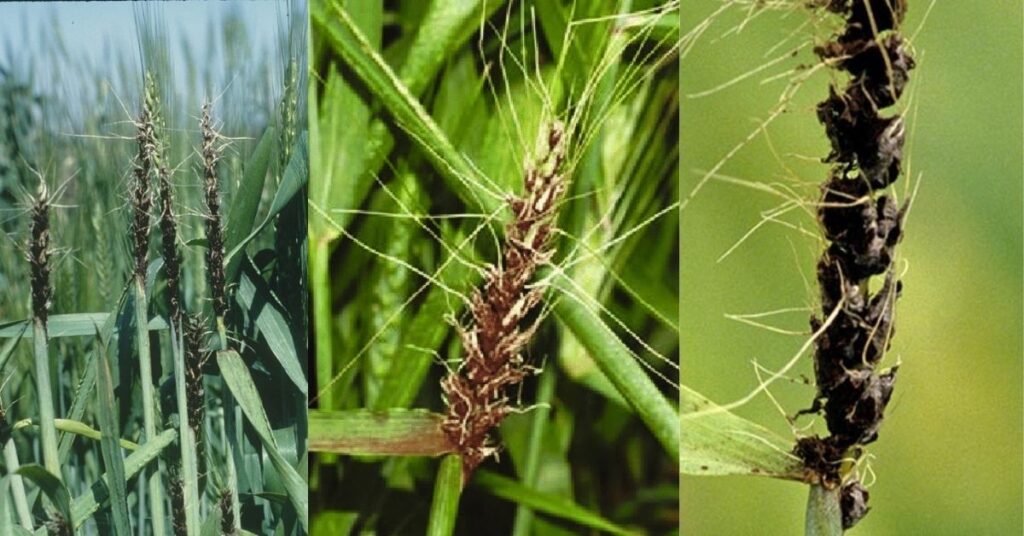
Prevention/control
- The diseased plants should be uprooted very carefully and sealed in polythene bags, buried in the soil or burnt.
- Only healthy and certified seeds should be sown.
- Seeds should be sown after treatment with Vitavax (Carboxin 37.5%+Thiram 37.5%) or Carbendazim 50% WP @2.5-3 g/kg of seed.
- Soak the seeds in water for 4 hours and dry its in strong sunlight in the month of May-June and store them for sowing next year.
- There is no effective treatment after spreading this disease.
Flag smut of wheat
It is a soil and seed borne disease. It is caused by a fungus called Urocystis agropyri. In this disease, brownish-black, broad, bloated formations parallel to the veins appear on the leaves. Later black powder is released from these formations.
Leaves get curled and infested leaves turn black and dry up. The grains do not develop in the ears of the diseased plants. The spores of the fungus are carried from one place to another by straw and grain. Its fungus can survive in the soil for a long time.
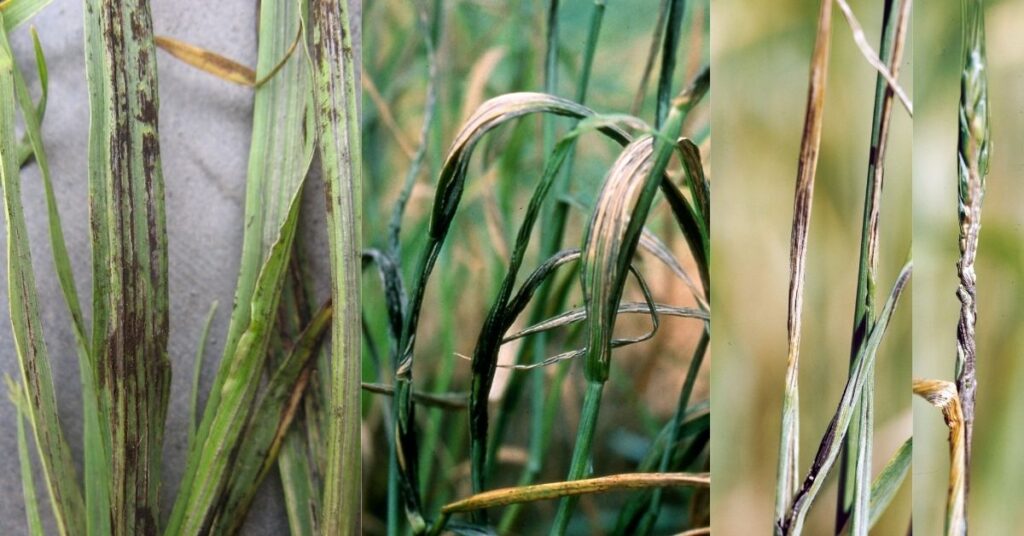
Prevention/control
- Carefully uproot and destroy the diseased plants.
- Sow certified seeds only.
- Sow the crop on time.
- Follow proper crop rotation.
- Sow the seed by treating it with Thiram (75% wp) @ 2-2.5 gm/kg of seed or with Vitavax (Carboxin 37.5%+Thiram 37.5%) @2.5-3 g/kg of seed.
Leaf blight of wheat (Alternaria blight)
This disease is caused by a fungus called Alternaria tritici. This fungus survives in wheat seeds or crop debris. The disease is more prevalent in moist environments when the plants are 1-1.5 months old.
Initially, the symptoms of the disease appear on the lower leaves and later gradually the symptoms of the disease affect the upper leaves as well.
In this disease, small circular or oval spots of yellowish-brown color are formed on the leaves and as the disease progresses, many spots join together and cause disease to the entire leaf. Due to the moisture in the atmosphere, black powder appears on these spots which contain spores of the fungus. Plants affected by this disease appear scorched.
Prevention/control
- Certified seeds and disease-resistant varieties should be sown.
- For the control of leaf blight of wheat spray Mencozeb 75% wp @400-500 gm/acre or Propiconazole 25 EC @200 ml/acre in 150-200 liters of water.
Ear cockle and tundu disease of wheat
- This disease of wheat is caused by anguina tritici nematode.
- In this disease the leaves of the plant become twisted.
- Earrings swell in place of grains and a glue-like sticky substance is found on the earrings.
- A yellow-brown colored structure is formed on the earrings.
- Diseased earrings are relatively small and remain green for a relatively long time.
- Diseased plants remain smaller than healthy plants.
- Galls are formed on all parts of the plant except the root.
Prevention/control
- Diseased plants should be uprooted and destroyed.
- Before sowing the crop, the field should be plowed in strong sunlight.
- Certified seeds should be sown.
- Proper crop rotation should be adopted.
- Before sowing, mixing of Nemaphas (granular) chemical at the rate of 10 kg per hectare in the field reduces the adverse effects of the disease.
- Affected seeds can be removed by flotation in 2% common salt solution the seeds infected with Nematode float on the solution because of their lighter weight.
Powdery mildew of wheat
- This disease is caused by a fungus called Erysiphe graminis tritici.
- Its symptoms appear in the form of white powder on leaves and spikes.
- As the disease progresses, the symptoms also reach on the earrings of the plant.
- Eventually, the color of the leaves becomes yellowish brown and the leaves dry up.
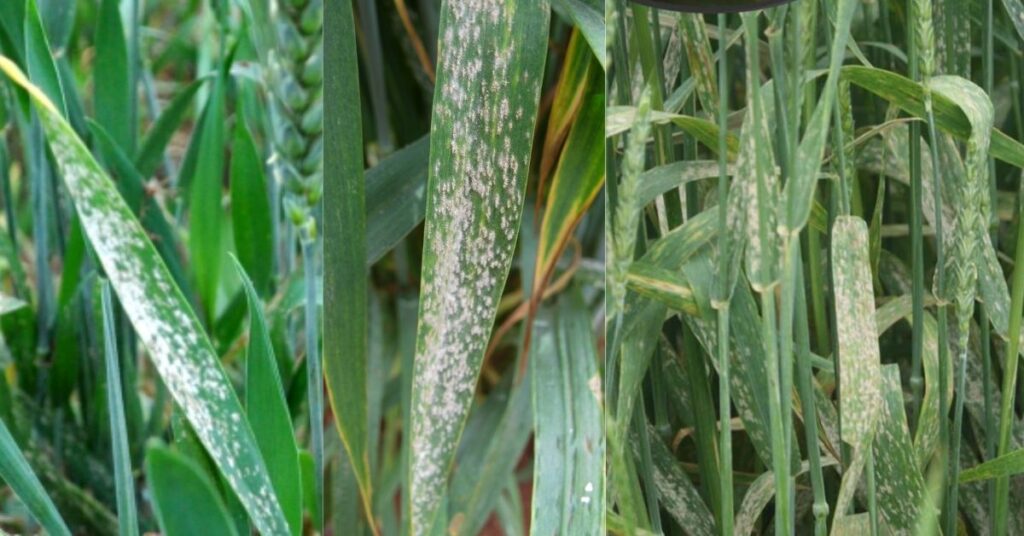
Prevention/control
- Disease-resistant varieties should be grown.
- Sow certified seeds.
- For the control of Powdery mildew of wheat spray propiconazole 25 EC @200 ml/acre in 150-200 litres of water.
Bunt disease of wheat
There are two types of Bunt disease that occur in wheat crops.
- Karnal bunt
- Hill bunt or stinking bunt
(A) Karnal bunt
This disease is caused by a fungus called Tilletia indica. Karnal bunt is also known as a partial bunt. In this disease, only a few grains in a particular ear turn into black powder. Its spores are found in the soil. This disease is more prevalent in moist environments.
(C) Hill bunt or stinking bunt
In this disease, some bloated, discolored grains are formed inside the ear, which is filled with sticky powder. This powder smells like rotten fish.
Prevention/control of Bunt diseases
- Sow disease resistant varieties (HD29, HD30, PBW343, PBW502, WH542, RAJ1555 etc.) for the prevention of bunt disease.
- Sow certified seeds only.
- Follow crop rotation.
- To control this disease, two sprays of Propiconazole 25 EC @200ml/acre or Carbendazim + Mancozeb @250gm/acre in 150-200 litres of water should be done.
- First spray should be done at flowering stage and second spray after a week.
Helminthosporium leaf blotch (spot blotch)
This disease is caused by a fungus called Bipolaris sorokiniana. In this disease, lesions on leaves are elongated to oval in shape and colors are dark brown. At maturity, the center of the spot often turns light brown to yellowish-brown surrounded by an irregular dark brown ring. Symptoms of the disease first appear on the lower leaves.
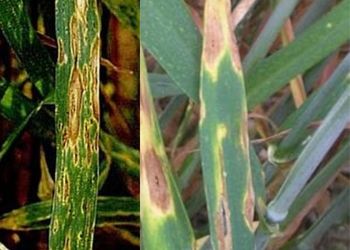
Prevention/control
- Sow certified seeds only.
- Sow the seed after treating with Vitavax (Carboxin 37.5%+Thiram 37.5%) or Carbendazim 50% wp @ 2.5-3 g/kg seed.
- To control this disease spray Propiconazole 25% EC @200 ml/acre in 150-200 litres of water.
Note: Any recommendations regarding the use of chemicals are for informational purposes only. Before using any type of chemical for weed, disease and pest control, consult the nearest agriculture shop or a local agricultural consultant.
How helpful was this post for you, tell me in the comment box and you can also give us your advice, your comment and advice are very important for us.
Thank you..!
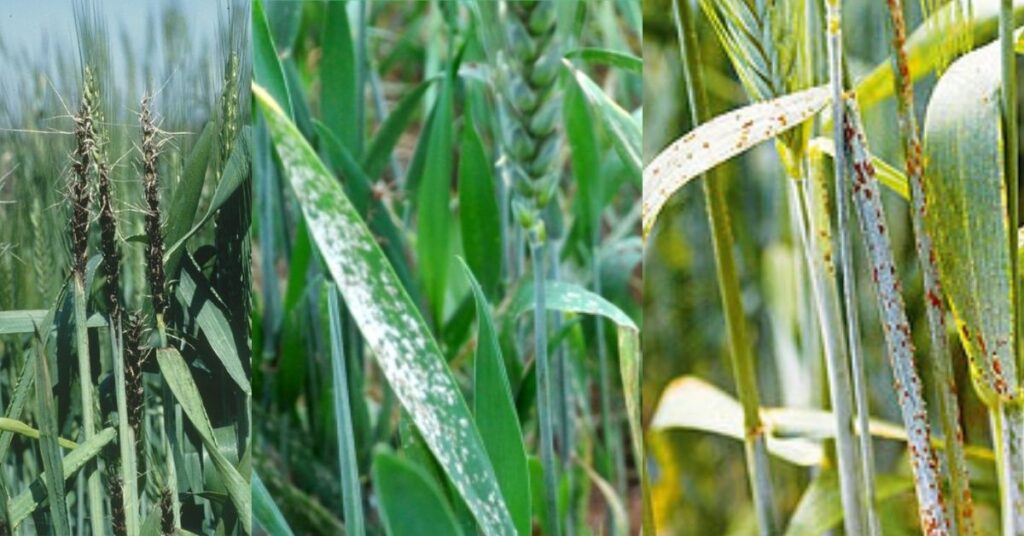
Hello sir
Any database available for this to do a research work in image processing?
What are the scope of this work in agriculture?